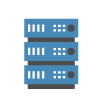Data centers
In the below table, you can compare the examples of system availability provided by “Uptime” Institute showing how the systems can be affected under more specific conditions.
“Tier” standards by “Uptime” Institute:
| "Tier" Step | Description | |
|---|---|---|
| 1 | The basis of the system is one-component, non-duplicating critical components (this level is practically not used anywhere). | |
| 2 | The basis of the system is N + 1, i.e. implemented critical components recovery. If one critical component is damaged, it can be removed and the system remains in N-components. Cooling, UPS, network equipment is duplicated, but there is only one distribution path. When replacing components, the equipment must be turned off. | |
| 3 | “Tier” 3 has everything what “Tier 2” has. Duplicate electrical installation, when there is no need to turn off the data center when changing components. 20 meter duplex line. Duplicate communication channel to client’s IT equipment. Minimum distances: up to rail or highway - 0,8km; to the airport or water body - 0.4km; to the public area - 9.8 m; between employees and guest houses - 9.1m (separate entrances). Separate installation, unpacking, security, data center premises. The walls of the Data Center building hold the fire for more than 1 hour. Dedicated building, fenced territory, physical protection. | |
| 4 | “Tier” 4 has everything what “Tier 3” has. Absolutely everything is doubled (there are no data about the “Tier” 4 step commercial data center operating in the Baltic States). |
Prepared according to https://en.wikipedia.org/wiki/Data_center and https://uptimeinstitute.com/

For a modern company, “Tier” 2 – 3 level data center services are most often required, and therefore provided by UAB Proservis.
The desirability of our proposed server configurations: Intel e5 processors, Intel motherboards, Kingston ECC memories, Intel SSD drives, dual power supplies and 99,8% availability of services per year.
Data center strength: stationary 20 kW power generator; redundant: electrical inputs, UPS, Internet line, main routers and hubs.
Our data center ensure:
Physical data center protection.
It is protected by physical means (fenced, guarded territory, room with armored doors) and an electronic security system.
Internet connection stability.
Internet access to the data center is provided by two independent Internet channels, therefore, when one of the channels stops working, the data flow is redirected to another. In this way, you will not feel interruptions to the operation of data centers due to interruptions to the Internet.
Data flow routing, switching.
Central routers and switches are redundant, so if one of them fails, the data flows are redirected to the duplicate device.
Ensuring electricity supply.
Electricity is supplied by two independent channels, from two different electrical substations. This ensures uninterrupted power supply not only in the event of a failure in a power line, but also in a power station. In this way power supply disturbances do not affect the work of the data centers.
Data center cooling.
Two independent systems are used for cooling the data center. In case of failure of an active cooling system a backup cooling system powers on. Both cooling systems are connected to different power sources, thus ensuring efficient cooling even in the event of power failure. Therefore, data center load on reliable cooling solutions ensures safe operation.



